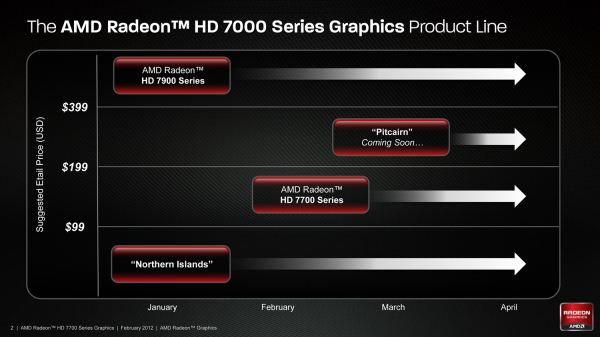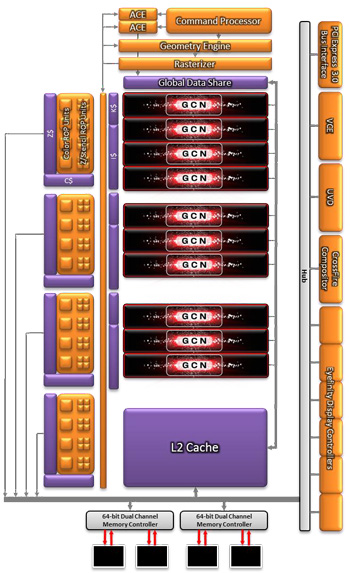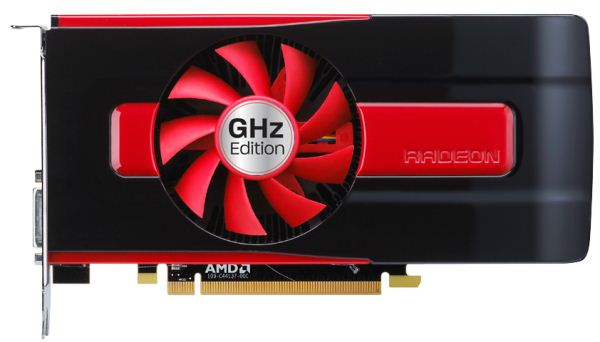AMD Radeon HD 7750 & Radeon HD 7770 GHz Edition Review: Evading The Price/Performance Curve
by Ryan Smith & Ganesh T S on February 15, 2012 12:01 AM EST- Posted in
- GPUs
- AMD
- HTPC
- GCN
- Radeon HD 7000
With the launch of Tahiti behind them, AMD is now firing on all cylinders to get the rest of their Southern Islands lineup out the door. Typically we’d see AMD launch their GPUs in descending order of performance, but this time AMD is taking a slight detour. Rather than following up the Tahiti based 7900 series with the Pitcairn based 7800 series, AMD is instead going straight to the bottom and launching the Cape Verde based 7700 series first.
Today AMD will be launching two cards based on the Cape Verde GPU: the Radeon HD 7750, and the Radeon HD 7770 GHz Edition. As the Juniper based 5700 series never got a proper Northern Islands successor, this is the first real update for the x700 series since the launch of the 5700 series in October of 2009. Given the success of the 5700 expectations are going to be high, and to fulfill those expectations AMD will be bringing to bear their new GCN architecture along with a full node jump with TSMC’s 28nm process. But will this be enough to enable the 7700 series to replicate the success of the 5700 series? Let’s find out.
| AMD GPU Specification Comparison | |||||||
| AMD Radeon HD 7770 GHz Edition | AMD Radeon HD 7750 | AMD Radeon HD 6850 | AMD Radeon HD 5770 | AMD Radeon HD 5750 | |||
| Stream Processors | 640 | 512 | 960 | 800 | 720 | ||
| Texture Units | 40 | 32 | 48 | 40 | 36 | ||
| ROPs | 16 | 16 | 32 | 16 | 16 | ||
| Core Clock | 1000MHz | 800MHz | 850MHz | 850MHz | 700MHz | ||
| Memory Clock | 4.5GHz GDDR5 | 4.5GHz GDDR5 | 4.8GHz GDDR5 | 4.8GHz GDDR5 | 4.6GHz GDDR5 | ||
| Memory Bus Width | 128-bit | 128-bit | 256-bit | 128-bit | 128-bit | ||
| Frame Buffer | 1GB | 1GB | 1GB | 1GB | 2GB | ||
| FP64 | 1/16 | 1/16 | N/A | N/A | N/A | ||
| Transistor Count | 1.5B | 1.5B | 1.7B | 1.04B | 1.04B | ||
| PowerTune Limit | 100W | 75W | N/A | N/A | N/A | ||
| Manufacturing Process | TSMC 28nm | TSMC 28nm | TSMC 40nm | TSMC 40nm | TSMC 40nm | ||
| Architecture | GCN | GCN | VLIW5 | VLIW5 | VLIW5 | ||
| Price Point | $159 | $109 | ~$149 | ~$99 | ~$89 | ||
With the 6000 series AMD effectively had a 5 chip stack: Caicos (6400), Turks (6600), the rebadged Juniper (6700), Barts (6800), and Cayman (6900). Since then integrated GPUs have effectively wiped out the low end of the market, and by the time Trinity launches later this year any product short of 6600 performance should be made redundant. As a result AMD has reigned in on their spread out stacks, leading to their 28nm Southern Islands product stack being just 3 products: Cape Verde (7700), Pitcairn (7800), and Tahiti (7900). Anything below the 7700 series will be rebadged Northern Islands parts, primarily Turks and Caicos.
But AMD’s product stack doesn’t tell the whole story. AMD will need to cover a wide range of products and price levels with only 3 GPUs, ranging from $109 to $550. As a result the performance levels of AMD’s various product series are being redefined somewhat, and nowhere is this more apparent right now than with the 7700 series. Why do we say that? Well let’s take a look at the specs and pricing.
Cape Verde, the GPU at the heart of the 7700 series, is AMD’s smallest 28nm GPU. With a die size of 123mm2 it’s only a hair bigger than the 118mm2 Turks GPU that powers the 6600 series. In terms of functional units we’re looking at 10 Compute Units, giving Cape Verde 640 SPs and 40 texture units. Elsewhere Cape Verde packs 16 ROPs, 1 geometry engine/rasterizer pair, and 512KB of L2 cache, with the chip coupled to a 128bit GDDR5 memory bus. Altogether compared to Tahiti this is around 31% of the CUs, 33% of the memory bus width, and half as many ROPs.
Interestingly, unlike Tahiti, Cape Verde’s CUs are organized slightly differently. GCN is designed around 4 CUs in each CU Array, with the 4 CUs sharing a read-only L1 instruction cache and a read-only L1 data cache. This is how both the 7970 and 7950 are organized, with the 7950 simply lopping off a whole CU array. However with Cape Verde 10 CUs doesn’t cleanly divide into groups of 4, so for the first time AMD has built something a bit different. In Cape Verde there are 3 CU arrays, populated in a 4/3/3 manner. With regards to performance there shouldn’t be a huge difference, but this does mean that there’s a bit less cache pressure on the CUs occupying the smaller CU arrays.
On the functionality side of things, backing up Cape Verde will be the rest of the Southern Islands family features we’ve already seen on Tahiti, such as DX10+ SSAA, PowerTune, Fast HDMI support, partially resident textures, D3D 11.1 support, and the still-AWOL Video Codec Engine (VCE). Even FP64 support is accounted for, however similar to how NVIDIA handles it on lower-end parts it’s a performance-limited implementation for compatibility and software development purposes, with FP64 performance limited to 1/16th FP32 performance.
As for the cards themselves, AMD will be releasing two Cape Verde cards: the Radeon HD 7750, and the Radeon HD 7770 GHz Edition. The 7770 will be a fully enabled Cape Verde with all 10 CUs (640 SPs) enabled, running at 1GHz for the core clock and 4.5GHz for the memory clock, with a PowerTune limit of 100W and an AMD defined typical board power of 80W. The 7750 meanwhile has 2 disabled CUs, giving it 512 SPs and 32 texture units, while the ROP count is unchanged at 16. The core clock will be 800MHz while the memory clock is the same as the 7770 at 4.5GHz, with a PowerTune limit of 75W and a typical board power of 55W. Both cards have a sub-10W idle TDP, while long-idle is sub-3W.
With those specs in mind, it’s interesting to note that the difference between the 7750 and 7770 is much wider than we’ve seen in past products. Compared to the 7750, the 7770 has 25% more CUs and a 25% core clock advantage, giving it a massive 56% shader and texture performance advantage over the 7750. With the 5700 series this gap was only 35%, and most of that was a result of core clock differences. The fact that the memory bandwidth is the same between the 7770 and 7750 equalizes things somewhat, but it’s still a huge difference for two cards that are in the same family.
This brings us back to where we started: how AMD is covering the entire $109+ market with only 3 GPUs. Between the massive performance gap between the 7700 series cards and the fact that the 7750 is a sub-75W part, it becomes increasingly obvious that the 7700 series is the de-facto replacement for both the 6600 series and the 5700 series. The 7750 will fill the 6670’s old role as AMD’s top sub-75W card, but as we’ll see its performance means it won’t be a complete replacement for the 5700 series. Instead the role of replacing the 5700 series falls to the much more powerful 7770.
As for today’s launch, AMD will be launching the 7750 at $109 and the 7770 at $159, which happens to be the same prices the 5770 and 5750 512MB launched at respectively. With midrange cards there usually aren’t any supply issues and we aren’t expecting the 7700 series launch to be any different, however as is customary AMD’s partners will be launching semi-custom cards from day one, so pricing will probably be inconsistent.
At these prices the 7700 series will be competing with a number of last-generation cards. The 7750 will be up against AMD’s 5770/6770 and the absolute cheapest of NVIDIA’s GTX 550 Ti cards. Meanwhile the 7770 will be competing with AMD’s 6850 and 6870, along with NVIDIA’s GTX 460 and their cheapest GTX 560s. And as we’ll see in our benchmarks, this is ultimately going to be more than the 7700 series can handle.
| Winter 2011/2012 GPU Pricing Comparison | |||||
| AMD | Price | NVIDIA | |||
| $209 | GeForce GTX 560 Ti | ||||
| $179 | GeForce GTX 560 | ||||
| Radeon HD 6870 | $169 | ||||
| Radeon HD 7770 | $159 | ||||
| Radeon HD 6850 | $139 | ||||
| $119 | GeForce GTX 550 Ti | ||||
| Radeon HD 7750 | $109 | ||||
| Radeon HD 6770 | $99 | ||||













155 Comments
View All Comments
KaDomoT - Wednesday, February 15, 2012 - link
Soemthing went very wrong during your Skyrim testing. I ran a 6870 in a similar rig (X4 955 @ 3.5ghz, 4gb ram, no ssd) @ 1920x1080 with 4x AA / 16x AF and A LOT of texture mods and my fps was MUCH higher than that. Not only that, but this was before the big performance boost in patch 1.4 / before I had even heard of SkyBoost!Admittedly my card was overclocked a good chunk (955 core / small mem oc) and my cpu had 600mhz on yours but no way that accounts for some massive 35+ fps difference especially when you guys have the performance patch and no mods.
takeship - Wednesday, February 15, 2012 - link
I think what everyone is missing here is that neither the 7750 or 7700 is really a card for builders, but for the OEM system builders, local shops, etc. For that segment, these cards are fastastic. Just look at the power and thermal loads - if you're HP, now you know you can sell the end customer a 7750 "HD Video" build for cheap, or a push the upgrade to 7770 based "HD Gaming" system without changing the power supply or cooling! That's huge for those guys. Simplification of the assembly line, part variety, etc etc. Same thing with Dad at home. Kid wants to play Battlefield? Buck at the shop around the corner knows that 7770 will get him there and then some playing on their "old" 1080p monitor without worrying that he'll see them back in 4 months when the system melts.CknSalad - Wednesday, February 15, 2012 - link
I think it's best to wait for kepler. There's really no point to be an early adopter of ati's 28nm cards. I'm sure the price will be fixed as the way it should comparable to nvidia's offerings. I just hope that nvidia is really taking the time to actually make quality gpus that are fairly mature. I wonder when there will be stable, legitimate drivers for ATI's 28nm cards. Hopefully that will give a decent boost in performance.haukionkannel - Wednesday, February 15, 2012 - link
Well this seems to be the trend. Older cards allways seems to better in bang for the buck department.It has been very slow time in GPU selling, so there are a lot of those old 5xx and 6xxx cards, so they have to sell those out before they can recure the prices for these new... Or nobody would buy those older allready produced cards. It is pity to us consumers, but a must to GPU manufacturers.
At this moment there is allmot none reason for AMD to make old 6xxx series cheaper, because the Nvidia is not making enough pressure. So they release new cards at extreme prices and sell those old card first.
Nogib - Wednesday, February 15, 2012 - link
I have been looking for an upgrade for my 4850 512MB card with a similar great bang for the buck that this card has given me all these years. Guess I'm still going to be looking. 7770 is close, but not enough of a leap to be honest. And while I'm sure the 78xx series will be great, I'm guessing it will be at a $250-$299 price range which is far beyond what I would ever consider spending on a video card. Sigh.Mathos - Wednesday, February 15, 2012 - link
You're right about the price/performance thing for a release.But, you also have to take some things into consideration. Some of the performance difference is likely due to the 6800 cards having a 256bit memory bus, as opposed to 128bit. Even with that standing I'm amazed the 7770 gets as close as it does. The main reason the 7770 is more expensive, I'm thinking is more likely so they can cease production on the 6800 series and dump inventory. The 68xx cards have been out for a while, and have benefited from many driver optimizations, but, you're not likely to see any more performance out of them from driver updates than what they already have. The 77xx cards are still based on a new core, which through driver updates will likely get much better performance over time.
Bottom line for me though, is, does it perform better than the 5770 that I currently have. Which, it does so considerably. More than could be said for the 6770. It also makes me wonder if they aren't gonna end up doing a 7790, basically a cut down pitcairn with a 256bit bus, like they did with the 6790.
chizow - Wednesday, February 15, 2012 - link
lol Hi rarson. :)Looks like you almost get it. Don't worry once the 7800 parts launch it'll fill in the blanks for you. The entire 7-series product stack pricing fails, top to bottom.
marc1000 - Wednesday, February 15, 2012 - link
actually the 7850 is the real star here. a board that does not require pci-e power and is able to almost match the 5770 in performance on most of the games. that was a 100w card.in the other hand, this makes me a little worried about the power requirements of 7800 series. i am hoping that both 7850 and 7870 will require only 1 pci-e power plug. my case is not big enough to handle more heat than that, and this is why i dont upgrade to a GTX560 (2x power connectors).
mczak - Thursday, February 16, 2012 - link
I think for the 7850 there is a possibility it would only have 1 power connector.The expectation is that Pitcairn is roughly "2xCape Verde", which means it should have roughly twice the power draw too. Twice the 7750 power draw is easily under 150W, whereas twice the 7770 power draw is not (well close actually according to measurements, but clearly these cards want to allow powertune +20% settings and overclocking).
That would be similar to HD6850/HD6870 where the 6850 only has one pcie power connector but the 6870 has two.
marc1000 - Thursday, February 16, 2012 - link
i meant 7750 is the star here.